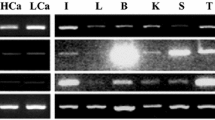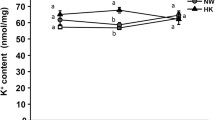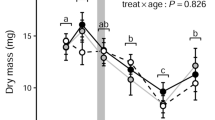Abstract
Changes in Ca2+ content and flux, and the development of skin chloride cells in embryos and larvae of tilapia, Oreochromis mossambicus, were studied. Tilapia embryos hatched within 96h at an ambient temperature of 26–28°C. Total body Ca2+ content was maintained at a constant level, about 4–8 nmol per individual, during embryonic development. However, a rapid increase in body Ca2+ level was observed after hatching, 12.8 to 575.3 nmol per individual from day 1 to day 10 after hatching. A significant influx and efflux of Ca2+ occurred during development, with the average influx rate for Ca2+ increasing from 5.9 pmol mg−1 h−1 at 48h postfertilization to 47.8 pmol mg−1 h−1 at 1 day posthatching. The skin was proposed as the main site for Ca2+ influx before the development of gills, and the increased Ca2+ influx may be ascribed to gradual differentiation of skin surface and chloride cells during embryonic development. Ca2+ efflux was 16–56 pmol mg−1 h−1 in 1-day-old larvae. The resulting net influx of Ca2+, 10–12 pmol mg−1 h−1, accounted for the increased Ca2+ content after hatching. When comparing the measured and estimated ratios of efflux and influx, active transport was suggested to be involved in the uptake of Ca2+. Chloride cells, which may be responsible for the active uptake of Ca2+, started to differentiate in the skin of embryos 48h after fertilization, and the density of chloride cells increased following the development. A possibility of active transport for Ca2+ in early developmental stages of tilapia is suggested.
Similar content being viewed by others
References cited
Alderdice, D.F. 1988. Osmotic and ionic regulation in teleost eggs and larvae. In Fish Physiology. Vol. XI, part A, pp. 163–251. Edited by W.S. Hoar and D.J. Randall. Academic Press, San Diego.
Brown, D.J.A. and Lynam, S. 1981. The effect of sodium and calcium concentrations on the hatching of eggs and the survival of the yolk sac fry of rainbow trout, Salmo trutta L. at low pH. J. Fish Biol. 19: 205–211.
Eddy, F.B. 1982. Osmotic and ionic regulation in captive fish with particular reference to salmonids. Comp. Biochem. Physiol. 73B: 125–141.
Eddy, F.B., Ward, M.R., Talbot, C. and Primmett, D. 1990. Ionic movement across the chorion in newly shed salmon eggs (Salmo salar L.). J. Comp. Physiol. 159B: 771–776.
Fleming, W.R., Brehe, J. and Hanson, R. 1973. Some complicating factors in the study of the calcium metabolism of teleosts. Am. Zool. 13: 793–797.
Flik, G., Fenwick, J.C., Kolar, Z., Mayer-Gostan, N. and Wendelaar Bonga, S.E. 1985. Whole-body calcium flux in cichli teleost fish (Oreochromis mossambicus) adapted to freshwater. Am. J. Physiol. 249: R432–437.
Fu, H. and Lock, R.A.C. 1990. Pituitary response to cadmium during the early development of tilapia (Oreochromis mossambicus). Aquat. Toxicol. 16: 9–18.
Guggino, W.B. 1980a. Water balance in embryos of Fundulus heteroclitus and F. bermudae adapted to sea water. Am. J. Physiol. 238R: 36–41.
Guggino, W.B. 1980b. Salt balance in embryos of Fundulus heteroclitus and F. bermudae adapted to sea water. Am. J. Physiol. 238R: 42–49.
Hayes, F.R., Darcy, D.A. and Sullivan, C.M. 1946. Changes in the inorganic constituents of developing salmon eggs. J. Biol. Chem. 163: 621–631.
Hwang, P.P. 1989. Distribution of chloride cells in teleost larvae. J. Morphol. 200: 1–8.
Hwang, P.P. 1990. Salinity effects on development of chloride cells in the larvae of ayu, Plecoglossus altivelis. Marine Biol. 107: 1–7.
Hwang, P.P. and Hirano, R. 1985. Effects of environmental salinity on intercellular organization and junctional structure of chloride cells in early stages of teleost development. J. Exp. Zool. 236: 115–126.
Hwang, P.P., Lin, S.W. and Lin, H.C. 1994. Different sensitivities to cadmium in tilapia larvae (Oreochromis mossambicus; Teleostei). Arch. Environ. Contam. Toxicol. (In press).
Hwang, P.P. and Wu, S.M. 1993. Role of cortisol in hypoosmoregulation in larvae of the tilapia (Oreochromis mossambicus). Gen. Comp. Endocrinol. 92: 318–324.
Ichii, T. and Mugiya, Y. 1983. Effects of a dietary deficiency in calcium on growth and calcium uptake from the aquatic environment in the goldfish, Carassius auratus. Comp. Biochem. Physiol. 77A: 259–262.
Kirshner, L.B. 1970. The study of NaCl transport in aquatic animals. Am. J. Zool. 10: 365–376.
Lee, C.S. and Hu, F. 1983. Influences of Ca and Mg ions on the egg survival of grey mullet, Mugil cephalus L. J. Fish Biol. 22: 13–20.
Margor-Jensen, A. and Adoff, G.R. 1987. Drinking activity of newly hatched larvae of cod (Gadus morhua L.). Fish Physiol. Biochem. 3: 99–103.
Marshall, W.S., Bryson, S.E. and Wood, C.M. 1992. Calcium transport by isolated skin of rainbow trout. J. Exp. Biol. 166: 297–316.
McCormick, S.D., Hasegawa, S. and Hirano, T. 1992. Calcium uptake in the skin of a freshwater teleost. Proc. Nat. Acad. Sci. U.S.A. 89: 3635–3638.
Milet, C., Peignoux-Deville, J. and Martelly, E. 1979. Gill calcium fluxes in the eel, Anguilla anguilla (L). Effects of Stannius corpuscles and ultimobranchial body. Comp. Biochem. Physiol. 63A: 63–70.
Oslon, K.R. and Fromm, P.O. 1973. A canning electron microscopic study of secondary lamellae and chloride cells of rainbow trout (Salmo gairdneri). Z. Zellforsch. Microsk. Anat. 143: 439–449.
Pang, P.K.T., Griffith, R.W., Maetz, J. and Pic, P. 1980. Calcium uptake in fishes. In Epithelial Transport in the Lower Vertebrates. pp. 120–132. Edited by B. Lahlou. Cambridge University Press, Cambridge.
Payan, P., Mayer-Gostan, N. and Pang, P.K.T. 1981. Site of calcium uptake in the freshwater trout gill. J. Exp. Zool. 216: 345–347.
Perry, S.F. and Flik, G. 1988. Characterization of branchial transepithelial calcium fluxes in freshwater trout, Salmo gairdneri. Am. J. Physiol. 254: R491–498.
Perry, S.F., Goss, G.G. and Fenwick, J.C. 1992. Interrelationships between gill chloride cell morphology and calcium uptake in freshwater teleosts. Fish Physiol. Biochem. 10: 327–337.
Perry, S.F. and Wood, C.M. 1985. Kinetics of branchial calcium uptake in the rainbow trout: effects of acclimation to various external calcium levels. J. Exp. Biol. 116: 411–433.
Peterson, R.H., Martin-Robichaud, D.J. 1986. Perivitelline and vitelline potentials as influenced by ambient ionic strength, natal salinity, and electrode electrolyte; and the influence of these potentials on cadmium dynamics within the egg. Can. J. Fish. Aquat. Sci. 43: 1445–1450.
Pratap, H.B., Fu, H., Lock, R.A.C. and Wendelaar Bonga, S.E. 1989. Effect of waterborne and dietary cadmium on plasma ions of the teleost, Oreochromis mossambicus, in relation to water calcium levels. Arch. Environ. Contam. Toxicol. 18: 568–575.
Rombough, P.J. and Garside, E.T. 1984. Disturbed ion balance in alevin of Atlantic salmon, Salmo solar, chronically exposed to sublethal concentrations of cadmium. Can. J. Zool. 62: 1443Bonga1450.
Tytler, P. and Blaxter, J.H.S. 1988. The effects of external salinity on the drinking rates of the larvae of herring, plaice and cod. J. Exp. Biol. 138: 1–15.
Ussing, H.H. 1949. Distinction by means of tracers between active transport and diffusion. The transfer of iodide across the isolated frog skin. Acta Physiol. Scand. 19: 43–56.
Young, P.S., McCormick, S.D., Demarest, J.R., Lin, R.J., Nishioka, R.S. and Bern, H.A. 1988. Effects of salinity, hypophysectomy, and prolactin on whole-animal transepithelial potential in the tilapia Oreochromis mossambicus. Gen. Comp. Endocrinol. 71: 389–397.
Author information
Authors and Affiliations
Rights and permissions
About this article
Cite this article
Hwang, PP., Tsai, YN. & Tung, YC. Calcium balance in embryos and larvae of the freshwater-adapted teleost, Oreochromis mossambicus . Fish Physiol Biochem 13, 325–333 (1994). https://doi.org/10.1007/BF00003437
Accepted:
Issue Date:
DOI: https://doi.org/10.1007/BF00003437




